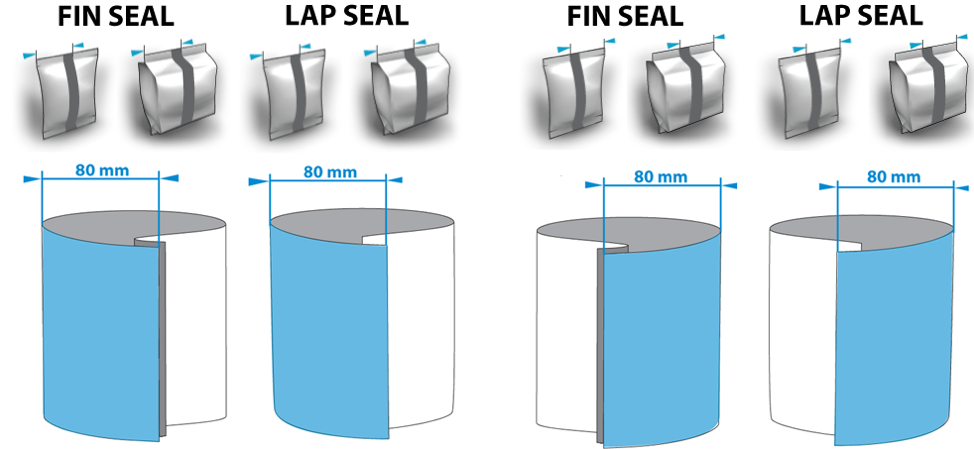The economy is thriving, the labor market is competitive and disruptive innovation is shaping the present and future of the food industry. Food plant owners are always looking for cost savings, especially in today’s fast-paced market. Could your packaging be a ripe opportunity?
Let’s look at a few considerations for optimizing your packaging process.
1. Switching from tape to glue for RSC packaging
There may be a cost-saving opportunity in your secondary packaging. Switching from tape to glue for sealing regular slotted containers (RSCs) could help your bottom line.
When taping cases, the flaps have to meet in the middle to ensure a proper seal. However with hot melt glue, the major and minor flaps can be shortened and still maintain proper closure. This is more cost-effective because the blank size is smaller, which in the end uses less corrugated cardboard.
Also, while tape sealing equipment is more affordable as an initial investment, the cases that run on the equipment (material cost) are a more expensive in the long term. For this reason, it’s always a good idea to look at the total cost — including equipment and materials — when purchasing equipment.
2. Changing from a lap seal to a fin seal
When it comes to primary packaging, opting for a fin seal over a lap seal can improve quality while decreasing cost, especially in stick packs.
A lap seal brings together two films that aren’t typically compatible with each other (such as OPP with LDPE), which is more difficult to seal, especially if product gets in the seals. On the other hand, a fin seal brings together the inside layers of the film, which are the same material and thus more compatible for sealing.
Fin seals are typically more cost-effective due to:
- Less re-work needed due to seal failures, which leads to less packaging material waste, less product waste and fewer consumer complaints
- Decrease in film thickness
- More production up time
- Lower material cost

3. Introducing a case packer
If you don’t use a case packer already, investing in one can greatly improve efficiency, especially if you’re trying to increase capacity. This equipment can boost speed on your packaging line by erecting cases and filling them with product. Not only does this yield long-term cost savings versus manual packing by plant personnel, but eliminating that labor also reduces employee injuries from repeat motion.
4. Investing in increased automation
In general, increasing automation at your food plant decreases overall waste. This technology requires a substantial upfront investment, but it can easily pay for itself in the long run if strategically implemented.
Automation isn’t just about boosting throughput and speed, either. For example, when you have someone manually packing cases, there are more opportunities for packaging to get damaged. There’s also an increased risk of quality problems, such as a worker placing the wrong flavor in the wrong carton or putting too much of one flavor in the carton, which could trigger a recall.
These are instances where materials and/or product can be wasted, which ultimately translates to lost dollars.
5. Monitoring and measuring packaging waste
Most facilities track packaging materials and waste to some degree, and some do it better than others. I’ve seen some companies that track cases, but rarely do they track items not included in the BOM like the actual tape or glue used to seal them.
At the end of the day, the more closely a facility monitors its waste, the more informed managers can be about increasing packaging efficiency. If you’re not tracking your material waste, it can be difficult to identify opportunities for improvement.
Are you lacking on your tracking and wondering where to begin? I’d start by analyzing your primary packaging, since it’s usually the most expensive packing component, and work downstream from there.
Set up regular meetings to review material waste numbers — perhaps every quarter — and include stakeholders from various departments.
6. Encouraging feedback from plant personnel
Your goal should always be continuous improvement, but you can’t get better without the input of the employees on the plant floor. These people are interacting with your product, packaging and process on a daily basis and often have some of the best ideas on how to improve it.
Create a culture of open communication and solicit feedback from plant personnel, whether that’s through a suggestion box, regular brainstorm meetings and/or incentives for providing new ideas.
Once you identify a cost-savings solution, you want to make sure it’s repeatable to maximize its potential. For example, if an employee finds a way to cut a 20-minute changeover down to five minutes, have that person write up a standard operating process (SOP) and train other operators.
There likely isn’t a glaring issue you’re overlooking, but it’s often little tweaks that can add up to bigger savings.
7. Establishing a preventative maintenance schedule
Don’t run your equipment into the ground until it breaks. A preventative maintenance program can help you schedule downtime instead of waiting for it to sneak up on you. Determine how often you need to replace parts before they break and create a schedule for routine maintenance.
This is a challenge for many facilities because the priority is always getting product out the door, but an unexpected breakdown during peak production hurts throughput more than scheduled downtime. Being proactive is always better than being reactive — and that doesn’t just apply to your packaging process.
Looking for specific guidance on how to optimize the packaging process at your facility? Email me at foodforthought@stellar.net or give our team a call at 904-260-2900 (toll free: 800-488-2900).


